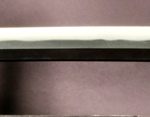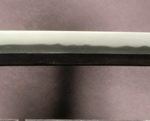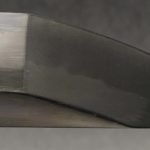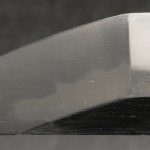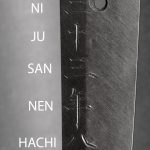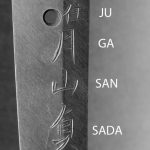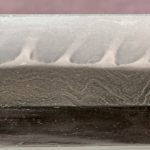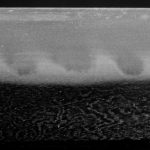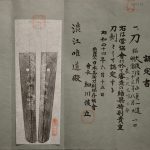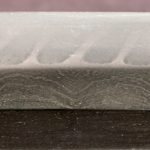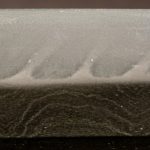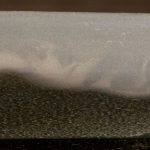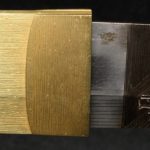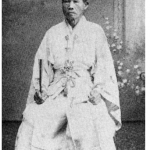GASSAN SADAKAZU
SADAKAZU, GASSAN
RATED 5.5 MILLION YEN
MEI: OSAKA JU GASSAN SADAKAZU TSUKURU
DATE: MEJI NI JU SAN NEN SAN GATSU BI (March 1890)
NAGASA: 70.326cm (27.6875″)
OVERALL: 88.9cm (35″)
MIHABA: 3.175cm (1.25″)
KASANE: 0.794cm (0.3125″)
SORI: 1.27cm (0.5″)
NAKAGO: UBU
MEKUGI ANA: ONE
YASURIME: KESHO
MUNE: IORI
HADA: ITAME WITH MASAME
HAMON: SAK CHOJI
BOSHI: KOMARU
HORIMONO OMOTE: NONE
HORIMONO URA: NONE
HABAKI: 2 PC. GOLD FOIL
SHIRASAYA
NBTHK TOKUBETSU KICHO
The current owner has decided to sell this sword and asked me to facilitate the transaction.
*Note, there has been some discussion regarding the validity of the mei on this sword. The sword received Tokubetsu Kicho papers dated 1969 from the NBTHK. These papers are commonly known as “green” papers. Most collectors are aware of the scandal involving the NBTHK in the mid to late 70’s where some of the prefectural branches were issuing fraudulent papers.
Does that mean these original Tokubetsu Kicho papers are fraudulent? Part of the NBTHK scandal? It is possible, yet I have no absolute proof either way. In fact, it would be impossible for me to know. I do know the papers were issued well before the scandal in the mid to late 70’s, as I understand it.
It is my opinion that the only way to clear this up once and for all is to submit it to shinsa. Unfortunately, neither the past or current owner are willing to incur these costs.
As I serve only as the intermediary, I certainly will not absorb these costs.
*So, what is imperative for you, the potential buyer, is to have an absolutely clear understanding on the issues surrounding this sword.
Facts I made abundantly clear in personal correspondence with the last buyer and facts I want everyone who reads this to understand.
In the name of complete transparency please make note of the following points. Points which perhaps were not clear enough when I last listed this sword:
- This sword is a consignment, meaning I have been hired to sell it.
- As an intermediary between owner and buyer I have an obligation to both.
- In that regard I will say to future owners/ buyers the same thing that I made abundantly clear to the current owner. And that is that I see do discrepancies in the mei.
- On behalf of the owner, I reiterate: A). this sword was papered in 1969, years before the NBTHK scandal (see above). B). Sadakazu worked for approximately 70 years in total. Certainly, his mei changed over time, much as your handwriting would.
- I make no claims to being an expert, but in my opinion this sword has a reasonable chance of passing shinsa if resubmitted. Note however, NO papers or shinsa results from any organization are guarantees. ALL papers, from ALL organizations are opinions ONLY. Any sword may fail shinsa today and pass the next one. I have seen this happen many times.
- Potential buyers must understand that this sword is not the property of Yakiba.com, never has been.
- Therefore, Yakiba.com makes no guarantees given or implied that this sword will pass or fail any future Shinsa.
**Therefore, and I reiterate, it is up to YOU the potential buyer to do your own research and form your own opinion. It is your responsibility to do this prior to purchase, not after!
I have provided sufficient photos for your research.
NOTE: As with all swords information provided in this listing regarding Gassan Sadakazu or any other is provided as a courtesy (see policy page). Information is given to assist with your research and is not to be taken as an indication of authenticity.
References: Shinshinto Taikan pg 156, TokoTaikan TK-244, Nihon Toko Jiten Shinto Vol. S-374, Nihonto Meikan NMK-348
From Sesko’s, Japanese swordsmiths A-Z:
SADAKAZU (貞一), Genji (元治, 1864-1865), Settsu – “Gassan Unryūshi Sadakazu” (月山雲龍子貞一), “Naniwa ni oite Kinpō-jōhen Gassan Sadakazu kore o tsukuru” (於浪花金宝城辺月山貞一造之), “Gassan Sadakazu” (月山貞一), “Gassan Hayato Minamoto Sadakazu tsukuru”
(月山隼人源貞一造), “Naniwa-jū Gassan Unryūshi Minamoto Sadakazu” (浪華住月山雲龍子源貞一), “Naniwa-jū Gassan Yagorō Sadakazu seitan hori-dōsaku” (浪華住月山弥五 郎貞一精鍛彫同作, “carefully forged andcarvings engraved by Gassan Yagorō Sadakazu from Naniwa”), “Dainippon Gassan Sadakazu horimono-dōsaku” (大日本月山貞一彫物同作), real name Gassan Yagorō (月山弥五郎), he was born in the second month of Tenpō seven (天保, 1836) in the village of Sugoshi (須越) in Ōmi ́s Inugami district (犬上), he was adopted by Gassan Sadayoshi (貞吉) at the age of seven and was appointed teishitsu-gigei ́in (帝室技芸員) in Meiji 39 (明治, 1906), this rank was about the predecessor of the modern ningen-kokuhō and Sadakazu was besides of Miyamoto Kanenori (宮本包則) the only swordsmith who held this important rank, his gō were Kōkensai (光顕斎), Unryūshi (雲龍子), and Suiyūshi (水勇子), he died on July 11th 1918 at the age of 84, we know dated blades from the third year of Kaei (嘉永, 1850) – he was 15 years old at that time – until his year of death in 1918, that means he was about 70 years active as a swordsmith, he mastered all traditions and is considered together with Honjō Yoshitane (本荘義胤) and Kurihara Nobuhide (栗原信秀) as the greatest horimono artists of the bakumatsu and early gendaitō era, he also played an important role in the transmission of the craft of sword forging to the later gendaitō smiths, so some count Suishinshi Masahide as founder, and Gassan Sadakazu als last great master of the shinshintō, his blades have a rather long nagasa, a shallow sori, a wide mihaba, and a chū or an ō-kissaki, that means altogether a magnificent shape, but also some sugata in the style of the early Muromachi period are known, blades made during the Keiō era (慶応, 1865-1868) are especially large, he made many copies of kotō works and worked after the ban on wearing swords also for the military where more narrow and shorter blades were in demand, he forged the ayasugu-hada of the Gassan school, a masame of the Yamato tradition, or also a mokume, ko-mokume, or itame, the hamon is a beautiful chōji-midare in nioi-deki with a narrow yakihaba and long ashi in the style of the Ōei-Bizen school (応永備前), a ko-chōji-midare in ko-nie-deki, a chū-suguha-hotsure in the style of the Yamashiro tradition, or a gunome-midare with thick nie and nioi and plentiful hataraki in the style of the Sōshū tradition, the bōshi is maru, midare-komi or yakitsume, various horimono are known, for example dragons, dragon and a plum tree, ken-maki-ryū, waterfall, Fudō-Myōō, bonji and many more, all done very elaborate and skilful, some remind of horimono of Ikkanshi Tadatsuna (一竿子忠綱), his tangs are long and carefully finished, they have a kurijiri and sujikai-yasurime with keshō, during the Keiō and Meiji eras he signed with a characteristical koku ́in, in Taishō five (1916) he forged a tachi on the occasion of the enthronement of emperor Yoshihito (嘉仁, 1879-1926), jōjō-saku.
This sword is sold “as is”, and “Sale is Final”.
Lastly, I must say that regardless of shoshin or gimei this is a beautiful sword. It is quite long at nearly 28″. It is flawless has both outstanding hada and hamon and is a pleasure to study.
$14,500 plus S/H and any associated fees (PP, Wire, etc.)
REDUCED
$13000 plus S/H and any associated fees (PP, Wire, etc.) OBO.
